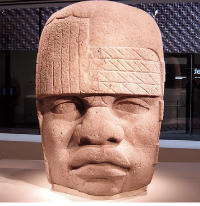
This colossal head dates from 1200–900 B.C.
Beginning next month on Feb. 19, the de Young will feature one of the most comprehensive exhibitions of Olmec culture ever presented to the public. Recognized as one of America's oldest civilizations, the Olmec were known for their ambitious artworks, most notably colossal heads carved from enormous boulders.
Vessels, figures, ornamentations, and ritual masks reveal the story of the Olmec, which began around 1400 B.C. in south central Mexico. Jade, obsidian, magnetite, and other materials were manipulated into representations of animals, spirit beings and humans. They also depicted supernatural beings alongside naturalistic portrayals of objects found in daily life, the symbolism of both the sacred and secular. Stylized animals and spirit entities occupied the natural world simultaneously, reflecting religious meaning and personal history.
The colossal heads are the most enterprising, distinctive and attractive remnants of the Olmec. Now widely considered to be representations of their leaders, these enormous heads were sometimes applied as parts of other monuments. Utilizing primitive tools, the Olmec were able to carve magnificent detailed faces, no two alike, out of basalt, an impossibly hard stone to manipulate. Weighing between 25 and 55 tons, these massive head sculptures, when finished, were moved dozens of miles and took hundreds of people months to move to their final destinations. Some heads were variously ravaged, buried and disinterred, displaced to new locations, or completely rebuilt. Mutilation had significance beyond common defacement and may have been attributed to invaders. Other historians speculate that the colossal heads were removed from thrones and recycled as freestanding art objects, the defacement having more to do with the symbolic removal of the previous ruler's power and authority.
The Olmec were innovators of art and invention. The concept of zero as attributed to the Long Count calendar was used by many Mesoamerican cultures. Originally believed to have originated with the Mayans, the idea may have begun with the Olmec. Furthermore, the Olmec are thought to be one of the earliest practitioners of human sacrifice. They were also one of the first societies that played ball games. (Some of the colossal heads even depict leaders as ball players.) As the first Mesoamerican civilization, they were the precursors of other cultures.
This exhibition represents a vast collection of the era comprised of loans from over 25 museums, some of the objects never before seen in the United States.
Olmec: Colossal Masterworks of Ancient Mexico: Feb. 19 through May 18, 2011; de Young Museum, 50 Hagiwara Tea Garden Drive in Golden Gate Park, 415-750-3600, www.deyoung.org








